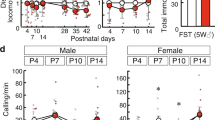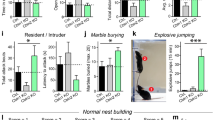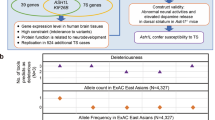Abstract
Mutations in SLITRK1 are found in patients with Tourette's syndrome and trichotillomania. SLITRK1 encodes a transmembrane protein containing leucine-rich repeats that is produced predominantly in the nervous system. However, the role of this protein is largely unknown, except that it can modulate neurite outgrowth in vitro. To clarify the role of Slitrk1 in vivo, we developed Slitrk1-knockout mice and analyzed their behavioral and neurochemical phenotypes. Slitrk1-deficient mice exhibited elevated anxiety-like behavior in the elevated plus-maze test as well as increased immobility time in forced swimming and tail suspension tests. Neurochemical analysis revealed that Slitrk1-knockout mice had increased levels of norepinephrine and its metabolite 3-methoxy-4-hydroxyphenylglycol. Administration of clonidine, an α2-adrenergic agonist that is frequently used to treat patients with Tourette's syndrome, attenuated the anxiety-like behavior of Slitrk1-deficient mice in the elevated plus-maze test. These results lead us to conclude that noradrenergic mechanisms are involved in the behavioral abnormalities of Slitrk1-deficient mice. Elevated anxiety due to Slitrk1 dysfunction may contribute to the pathogenesis of neuropsychiatric diseases such as Tourette's syndrome and trichotillomania.
This is a preview of subscription content, access via your institution
Access options
Subscribe to this journal
Receive 12 print issues and online access
$259.00 per year
only $21.58 per issue
Buy this article
- Purchase on Springer Link
- Instant access to full article PDF
Prices may be subject to local taxes which are calculated during checkout




Similar content being viewed by others
References
Aruga J, Mikoshiba K . Identification and characterization of Slitrk, a novel neuronal transmembrane protein family controlling neurite outgrowth. Mol Cell Neurosci 2003; 24: 117–129.
Aruga J, Yokota N, Mikoshiba K . Human SLITRK family genes: genomic organization and expression profiling in normal brain and brain tumor tissue. Gene 2003; 315: 87–94.
Kobe B, Deisenhofer J . Proteins with leucine-rich repeats. Curr Opin Struct Biol 1995; 5: 409–416.
Brose K, Tessier-Lavigne M . Slit proteins: key regulators of axon guidance, axonal branching, and cell migration. Curr Opin Neurobiol 2000; 10: 95–102.
Patapoutian A, Reichardt LF . Trk receptors: mediators of neurotrophin action. Curr Opin Neurobiol 2001; 11: 272–280.
Chen Y, Aulia S, Li L, Tang BL . AMIGO and friends: an emerging family of brain-enriched, neuronal growth modulating, type I transmembrane proteins with leucine-rich repeats (LRR) and cell adhesion molecule motifs. Brain Res Brain Res Rev 2006; 51: 265–274.
Abelson JF, Kwan KY, O'Roak BJ, Baek DY, Stillman AA, Morgan TM et al. Sequence variants in SLITRK1 are associated with Tourette's syndrome. Science 2005; 310: 317–320.
Züchner S, Cuccaro ML, Tran-Viet KN, Cope H, Krishnan RR, Pericak-Vance MA et al. SLITRK1 mutations in trichotillomania. Mol Psychiatry 2006; 11: 887–889.
Leckman JF . Tourette's syndrome. Lancet 2002; 360: 1577–1586.
Robertson MM, Cavanna AE . The Gilles de la Tourette syndrome: a principal component factor analytic study of a large pedigree. Psychiatr Genet 2007; 17: 143–152.
Hautmann G, Hercogova J, Lotti T . Trichotillomania. J Am Acad Dermatol 2002; 46: 807–821; quiz 822–806.
Inoue T, Hatayama M, Tohmonda T, Itohara S, Aruga J, Mikoshiba K . Mouse Zic5 deficiency results in neural tube defects and hypoplasia of cephalic neural crest derivatives. Dev Biol 2004; 270: 146–162.
Sakai K, Miyazaki J . A transgenic mouse line that retains Cre recombinase activity in mature oocytes irrespective of the cre transgene transmission. Biochem Biophys Res Commun 1997; 237: 318–324.
Sadakata T, Washida M, Iwayama Y, Shoji S, Sato Y, Ohkura T et al. Autistic-like phenotypes in Cadps2-knockout mice and aberrant CADPS2 splicing in autistic patients. J Clin Invest 2007; 117: 931–943.
Satoh Y, Endo S, Ikeda T, Yamada K, Ito M, Kuroki M et al. Extracellular signal-regulated kinase 2 (ERK2) knockdown mice show deficits in long-term memory; ERK2 has a specific function in learning and memory. J Neurosci 2007; 27: 10765–10776.
Tang YP, Shimizu E, Dube GR, Rampon C, Kerchner GA, Zhuo M et al. Genetic enhancement of learning and memory in mice. Nature 1999; 401: 63–69.
Porsolt RD, Bertin A, Blavet N, Deniel M, Jalfre M . Immobility induced by forced swimming in rats: effects of agents which modify central catecholamine and serotonin activity. Eur J Pharmacol 1979; 57: 201–210.
Wesolowska A, Nikiforuk A . Effects of the brain-penetrant and selective 5-HT6 receptor antagonist SB-399885 in animal models of anxiety and depression. Neuropharmacology 2007; 52: 1274–1283.
Silva RH, Kameda SR, Carvalho RC, Takatsu-Coleman AL, Niigaki ST, Abilio VC et al. Anxiogenic effect of sleep deprivation in the elevated plus-maze test in mice. Psychopharmacology (Berl) 2004; 176: 115–122.
Pringsheim T, Davenport WJ, Lang A . Tics. Curr Opin Neurol 2003; 16: 523–527.
Robertson MM . Attention deficit hyperactivity disorder, tics and Tourette's syndrome: the relationship and treatment implications. A commentary. Eur Child Adolesc Psychiatry 2006; 15: 1–11.
Schlicker E, Göthert M . Interactions between the presynaptic α2-autoreceptor and presynaptic inhibitory heteroreceptors on noradrenergic neurones. Brain Res Bull 1998; 47: 129–132.
Hu H, Real E, Takamiya K, Kang MG, Ledoux J, Huganir RL et al. Emotion enhances learning via norepinephrine regulation of AMPA-receptor trafficking. Cell 2007; 131: 160–173.
Bremner JD, Krystal JH, Southwick SM, Charney DS . Noradrenergic mechanisms in stress and anxiety. I. Preclinical studies. Synapse 1996; 23: 28–38.
Belmaker RH, Agam G . Major depressive disorder. N Engl J Med 2008; 358: 55–68.
Bremner JD, Krystal JH, Southwick SM, Charney DS . Noradrenergic mechanisms in stress and anxiety. II. Clinical studies. Synapse 1996; 23: 39–51.
Rodgers RJ, Cole JC . Effects of scopolamine and its quaternary analogue in the murine elevated plus-maze test of anxiety. Behav Pharmacol 1995; 6: 283–289.
Brioni JD, O'Neill AB, Kim DJ, Decker MW . Nicotinic receptor agonists exhibit anxiolytic-like effects on the elevated plus-maze test. Eur J Pharmacol 1993; 238: 1–8.
Szyndler J, Sienkiewicz-Jarosz H, Maciejak P, Siemiatkowski M, Rokicki D, Czlonkowska AI et al. The anxiolytic-like effect of nicotine undergoes rapid tolerance in a model of contextual fear conditioning in rats. Pharmacol Biochem Behav 2001; 69: 511–518.
Weiner MF, Svetlik D, Risser RC . What depressive symptoms are reported in Alzheimer's patients? Int J Geriatr Psychiatry 1997; 12: 648–652.
Grados MA, Walkup JT . A new gene for Tourette's syndrome: a window into causal mechanisms? Trends Genet 2006; 22: 291–293.
Takeuchi H, Yatsugi S, Yamaguchi T . Effect of YM992, a novel antidepressant with selective serotonin re-uptake inhibitory and 5-HT 2A receptor antagonistic activity, on a marble-burying behavior test as an obsessive-compulsive disorder model. Jpn J Pharmacol 2002; 90: 197–200.
Matsushita M, Egashira N, Harada S, Okuno R, Mishima K, Iwasaki K et al. Perospirone, a novel antipsychotic drug, inhibits marble-burying behavior via 5-HT1A receptor in mice: implications for obsessive-compulsive disorder. J Pharmacol Sci 2005; 99: 154–159.
Kurlan R, Como PG, Miller B, Palumbo D, Deeley C, Andresen EM et al. The behavioral spectrum of tic disorders: a community-based study. Neurology 2002; 59: 414–420.
Robertson MM . Mood disorders and Gilles de la Tourette's syndrome: an update on prevalence, etiology, comorbidity, clinical associations, and implications. J Psychosom Res 2006; 61: 349–358.
Weissman MM, Fyer AJ, Haghighi F, Heiman G, Deng Z, Hen R et al. Potential panic disorder syndrome: clinical and genetic linkage evidence. Am J Med Genet 2000; 96: 24–35.
Badner JA, Gershon ES . Meta-analysis of whole-genome linkage scans of bipolar disorder and schizophrenia. Mol Psychiatry 2002; 7: 405–411.
Potash JB, Zandi PP, Willour VL, Lan TH, Huo Y, Avramopoulos D et al. Suggestive linkage to chromosomal regions 13q31 and 22q12 in families with psychotic bipolar disorder. Am J Psychiatry 2003; 160: 680–686.
McGuffin P, Knight J, Breen G, Brewster S, Boyd PR, Craddock N et al. Whole genome linkage scan of recurrent depressive disorder from the depression network study. Hum Mol Genet 2005; 14: 3337–3345.
Sullivan GM, Coplan JD, Kent JM, Gorman JM . The noradrenergic system in pathological anxiety: a focus on panic with relevance to generalized anxiety and phobias. Biol Psychiatry 1999; 46: 1205–1218.
Neumeister A, Daher RJ, Charney DS . Anxiety disorders: noradrenergic neurotransmission. Handb Exp Pharmacol 2005; 169: 205–223.
Acknowledgements
We thank Dr Tadafumi Kato and Dr Takeo Yoshikawa (RIKEN BSI) for their critical comments on the paper, Dr Mika Tanaka and Ms Chieko Nishioka for their assistance in generating Slitrk1-knockout mice, Ms Chihiro Homma for her assistance in behavioral analysis and Mr Masaki Kumai (Support Unit for Animal Experiments, RIKEN BSI) for his help in generating the anti-Slitrk1 antibody. This study was supported by RIKEN BSI funds and the Japan Society for the Promotion of Science.
Author information
Authors and Affiliations
Corresponding author
Additional information
Supplementary Information accompanies the paper on the Molecular Psychiatry website (http://www.nature.com/mp)
Supplementary information
Rights and permissions
About this article
Cite this article
Katayama, K., Yamada, K., Ornthanalai, V. et al. Slitrk1-deficient mice display elevated anxiety-like behavior and noradrenergic abnormalities. Mol Psychiatry 15, 177–184 (2010). https://doi.org/10.1038/mp.2008.97
Received:
Revised:
Accepted:
Published:
Issue Date:
DOI: https://doi.org/10.1038/mp.2008.97
Keywords
This article is cited by
-
Leucine-rich repeat-containing synaptic adhesion molecules as organizers of synaptic specificity and diversity
Experimental & Molecular Medicine (2018)
-
Slitrk1 is localized to excitatory synapses and promotes their development
Scientific Reports (2016)
-
Heterozygous deletion of the LRFN2 gene is associated with working memory deficits
European Journal of Human Genetics (2016)
-
Elfn1 recruits presynaptic mGluR7 in trans and its loss results in seizures
Nature Communications (2014)
-
Reward circuitry dysfunction in psychiatric and neurodevelopmental disorders and genetic syndromes: animal models and clinical findings
Journal of Neurodevelopmental Disorders (2012)



